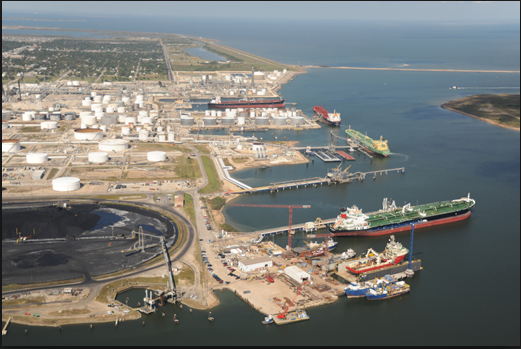Welcome to GLA! Leading the global logistics alliance.


Your location:Home > News > Non-container ports in Texas reaping gains from new plants
Time:2016-02-29 Publisher:glafamily Num:11087

The breakbulk and heavy-lift trade is alive and well in Texas. The state’s non-container ports are in the middle of a multiyear boom brought on by construction of massive industrial plants that are being built around the ports of Brownsville and Corpus Christi to take advantage of the abundance of shale oil and gas flowing out of the Eagle Ford oil shale field in South Texas.
“We’ve got three international projects that will start coming on line this year that we’ve been working on for six years or more,” said John LaRue, executive director of the Port of Corpus Christi. Those projects, which have fueled steady imports of heavy machinery and project components during their construction, will boost exports of breakbulk cargo through the port now that they are nearing completion. “They are not at all dependent on the price of oil, so we should see significant revenue increase next year.”
Brownsville, where total tonnage of bulk, liquid bulk and breakbulk cargoes moving by water, rail and truck jumped 21.3 percent last year, stands to become a major port for export of liquefied natural gas if the Federal Energy Regulatory Commission approves construction of three LNG plants that are proposed for the construction around the port.
The plants, which involve investment of $12 billion in their first phase alone, would be built to liquefy natural gas from the Eagle Ford shale fields for export to Asia in huge LNG tankers that would transit the new locks at the Panama Canal. “We see that as a huge opportunity for us, and would obviously benefit Panama as well,” said Eduardo Campirano, port director and CEO of the Port of Brownsville.
The companies building the three plants in Corpus Christi located them there so they could use the port’s breakbulk, bulk and liquid bulk facilities and to use Eagle Ford gas in their manufacturing processes. The projects include the $1.2 billion plant being built by TPCO America, a joint venture with China’s Tianjin Pipe Co., which will make oil and gas pipe for domestic and Latin American markets from billets and steel slabs.
“They will be importing raw material through the port and exporting pipe, wherever they can sell it, through the port,” LaRue said. The port still is handling some project cargo for the plant’s construction. “The plant is landlocked so they have to use our general cargo docks.”
As a partly Chinese-owned U.S. company, TPCO will dodge the retaliatory anti-dumping duties the U.S. Commerce Department is imposing on imports of Chinese steel.
A second Corpus Christi project is the $800 million specialty steel plant being built by Voest Alpine of Austria to produce hot briquette iron. The plant will bake the oxygen out of imported iron and export the resulting HBI through the port to Mexico and also back to Austria, where it will be made into steel for use in automotive plants. The new plant will start production in July or August.
The third project is an $800 million-plus plant being built by M&G Chemicals, part of Italy’s Mossi Ghisolfi Group, which will manufacture PET/PTA for plastic bottles. When it opens by year-end, it will be the largest vertically integrated single line in the world and the largest PET/PTA plant in the Americas. “We are building a new liquid bulk dock adjacent to their plant for import of chemical products,” LaRue said. M&G will ship up to 18,000 rail gondolas a year filled with PET pellets for the U.S. and Mexican markets. The port is building a new railyard to meet the plant’s needs.
Corpus Christi is in the next phase of a 10-year project to deepen its ship channel to 52 feet from 45 feet. It is working with the Army Corps of Engineers to get the $360 million project in the Obama administration’s budget for 2017. “If we don’t get in next year’s budget, we’ll be making the push for 2018,” LaRue said. “That will help us with oil exports, which we think will be important for the future.”
The Port of Brownsville recorded its third consecutive year of record tonnage last year because of imports of steel slab and coil in breakbulk ships for shipment by rail to steel plants in Mexico and of crude oil that is shipped by pipeline. It’s also seeing continuing imports of wind power components from China and Spain for installation at Texas wind farms, including blades, nacelles and wind towers.
The largest of the three LNG plants proposed for location around Brownsville is Rio Grande LNG, which would be built by Next Decade LNG. Another plant is Annova LNG, a subsidiary of Exelon. The smallest of the three is Texas LNG.
To handle the increase in cargo it anticipates, Brownsville opened a $27 million dock for breakbulk and project cargo last August and bought a mobile harbor crane for it. It is a twin to the existing Dock 16. The port also plans to build a $24 million to $26 million liquid cargo dock during the next year or so to handle deep-draft vessels.
Like Corpus Christi, Brownsville plans to deepen its ship channel to 52 feet from its current 42 feet. The Army Corps of Engineers recommended that depth last year, but the project wasn’t authorized for funding under the 2015 Water Resources Development Act. The port is working with the corps on design and engineering of the project so it can get it going quickly after receiving federal approval and funding.
Prev:Suez Canal tonnage, ship calls off to weak 2016 startNext:ASB logistics co.,lt has formally become the VIP member of GLA
Recommended Membership
Latest News